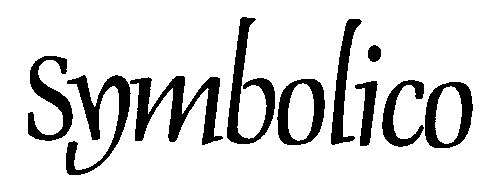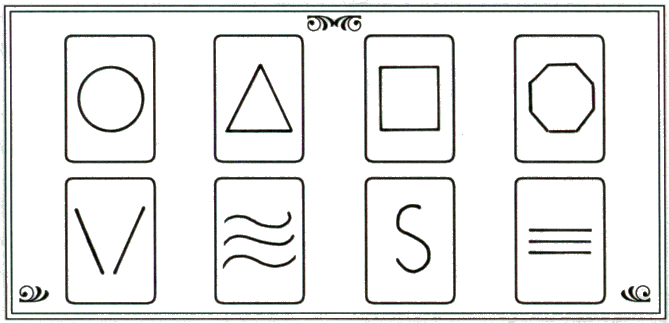
LET’S TAKE a look at a totally new forcing deck–based on the principles of the Bagshawe forcing pack–that I use with great success in my stage act. The deck is described here for the first time.
For about seven years, I have used as a forcing device a jumbo deck that is printed with symbols instead of card faces. It contains two groups of eight symbols, for a total of sixteen cards. One set from this symbol deck consists the eight symbols shown on the next page.
You will need two sets of these eight symbols. The order of the symbols in each set is unimportant, but the two sets of symbols should be arranged in the same sequence, and one set placed over the other to distance the duplicates in the packet. While there are in reality only eight different symbols, in performance you always speak of them as sixteen symbols.

This deck is used as follows: After you casually display the jumbo symbol cards, you have a spectator mix them, remove one and note the symbol on it. He is then instructed to place the card face down on the table, while he keeps the rest of the deck in his possession. Your back is turned throughout this procedure, so that you can see absolutely nothing. Despite all this, you can successfully name the selected card! Here is the pumping system that let’s you do that:
STATEMENT ONE: “You’re thinking of a geometrical shape.” If the answer is yes, you know the symbol must be one of those in Group One.
STATEMENT TWO: “The symbol has corners.” If the answer is no, the chosen symbol is the circle. If the answer is yes, you continue…
STATEMENT THREE: “More than three.” If the answer is no, the chosen symbol is the triangle. If yes, you say…
STATEMENT FOUR: “Yes, I see four…” Watch the subject. If you see him begin to say yes, finish your statement first with: “…It is a square, isn’t it!” However, if you see the subject hesitate or begin to say no, you again elaborate before he can answer: “…five, six, seven, eight. Eight corners. That would be an octagon, wouldn’t it?”
Now let’s return to Statement One.
STATEMENT ONE: “You’re thinking of a geometrical shape…” If you see the subject hesitate or begin to say no, the symbol must be in Group Two. You continue before he can contradict you: “NO, the lines just flew apart on me!” You then go to…
STATEMENT TWO: “I see several lines, though…” If you see a negative response looming, you finish the statement with: “…curving together to form a sort of curlicue, like an S shape.” But should the spectator agree that there are several lines, you go to…
STATEMENT THREE: “There are two…” If this receives a yes, the symbol is the broken V. If the subject starts to say no, you finish your statement with: “… three of them,” as if you are counting the lines in your mind.
STATEMENT FOUR: “They seem to be straight…” If this gets a yes, the symbol is the three horizontal lines. If you see the subject ready to disagree, you immediately conclude with: “… sort of parallel–if three wavy lines can be said to be parallel.”
Notice how the structure and delivery of these statements avoid or minimize all negative responses, and seem to flow toward a virtually unerring divination. The psychology on which this style of pumping has been modeled is that suggested by T.A. Waters(1). The logic behind the system makes it easy to learn, but the pumping statements must be convincingly delivered. How you phrase your statements is all important. You must try to impart a very slight undercurrent of undecidedness in your voice, as if you are straining to tune into the thoughts of the spectator.
I never use these cards as a stand-alone effect, but rather as an element in a one-ahead routine. To make the divination “play bigger” you can have the spectator draw his mentally chosen symbol as large as he can on a giant sketch pad or piece of cardboard. You keep your back turned while this is done. Then, after having delivered your pumping statements, thereby determining the spectator’s symbol, you draw it on another large pad or card. To conclude the test, expose both drawings to the audience, revealing your psychic “artistry”.

It is worth noting that the Bagshawe and Symbolico decks have one decided advantage over the ridged force packs detailed in Chapter One: With a pack containing three different ridged and marked cards, it is necessary for you to stand near the spectator to read the marks on the backs after he has finished cutting the cards. But forcing packs based on the Bagshawe concept permit you to maintain a considerable distance from your assistant throughout the test.
In magic’s literature there are dozens of effects that can benefit from the addition or substitution of the Bagshawe Deck or the Symbolico pack. You will be amazed at the impact these ingenious yet simple tools can bring to your work–providing you have a proper understanding of their presentation.
(1)Trionic, pp. 8-11; or Mind, Myth & Magick, pp. 76-80.
|
